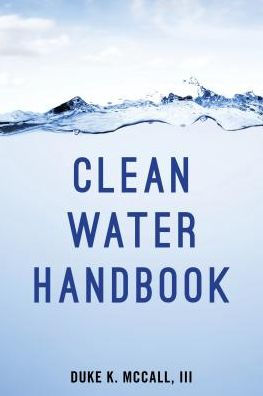5
1


Paperback(Fourth Edition)
$136.00
-
PICK UP IN STORECheck Availability at Nearby Stores
Available within 2 business hours
Related collections and offers
136.0
In Stock
Overview
First Update Since 2003! Completely updated to capture all new revisions and new aspects of the law, the new Clean Water Handbook provides environmental professionals with a comprehensive roadmap to the requirements, legal interpretations, and critical issues of water pollution control law. Written from a legal perspective but intended as a practical resource, the Handbook contains both the legal text of the Clean Water Act and the expert interpretation environmental professionals need to understand what their companies' responsibilities are and how they can fulfill them.Each chapter of this edition focuses on one major component of the Clean Water Act. These chapters provide readers with detailed examinations of the history and requirements of the various water programs. Readers can examine these chapters collectively for a fundamental understanding of the Clean Water Act, or they can use them as reference points as they evaluate the effectiveness of their own compliance programs.This book focuses on the federal Clean Water Act, but it also includes essential information for anyone responsible for complying with a state water pollution control program.

Product Details
| ISBN-13: | 9781598888188 |
|---|---|
| Publisher: | Bernan Press |
| Publication date: | 03/08/2017 |
| Edition description: | Fourth Edition |
| Pages: | 352 |
| Product dimensions: | 6.90(w) x 9.90(h) x 0.80(d) |
About the Author
Duke McCall is a partner at Morgan Lewis. His practice focuses on environmental law and complex litigation. He represents clients in contribution actions, enforcement proceedings, citizen suits, toxic tort litigation, and regulatory matters, including actions brought under the Comprehensive Environmental Response, Compensation, and Liability Act (Superfund), the Clean Water Act, the Clean Air Act, the Resource Conservation and Recovery Act, and analogous state laws.
Table of Contents
CHAPTER 1 INTRODUCTION1.1 Overview1.2 Brief History of the CWA1.3 Clean Water Act Goals and Policies1.4 Elements of the CWA1.5 The Discharge Prohibition1.5.1 Addition1.5.2 Pollutant1.5.3 Point Source1.5.4 Navigable Waters (‘‘Waters of the United States’’)1.6 Overview of this HandbookCHAPTER 2 THE NPDES PERMIT PROGRAM2.1 What Is an NPDES Permit2.2 What Discharges Require an NPDES Permit2.3 State and Federal Roles2.4 The Permit Process2.4.1 The Permit Application2.4.2 The Draft Permit and Comment Period2.4.3 Appealing the Final Permit Decision2.5 NPDES Permit Conditions2.6 Monitoring Requirements2.7 Reporting RequirementsCHAPTER 3 EFFLUENT LIMITATIONS3.1 Introduction3.2 Forms of Permit Limitations3.3 Technology-Based Limitations3.3.1 BPT3.3.2 BAT3.3.3 BCT3.3.4 NSPS3.3.5 Variances3.4 Water Quality–Based Limitations3.4.1 Water Quality Standards3.4.2 Translating Standards into Chemical-Specific Permit Limitations3.4.2.1 Total Maximum Daily Loads3.4.2.2 Pollutant Trading3.4.2.3 Watershed Permits3.5 Toxicity-Based Limitations3.6 Biological Criteria3.7 Nutrient CriteriaCHAPTER 4 WHOLE EFFLUENT TOXICITY CONTROL4.1 Background4.2 When are WET Limitations Required?4.3 WET-Based Permit Limitations4.3.1 Types of Limitations4.3.2 Elements of WET Testing4.3.2.1 Test Organism4.3.2.2 Dilution Water4.3.2.3 Testing Frequency4.3.2.4 Flow-through v. Static and Renewal Tests4.3.2.5 Effluent Concentrations4.3.2.6 On-Site v. Off-Site Testing4.3.2.7 Grab v. Composite Sampling4.3.2.8 Acute-to-Chronic Ratio4.3.3 WET Permit Requirements4.3.4 Toxicity Identification and Reduction EvaluationsCHAPTER 5 STORM-WATER DISCHARGES5.1 The Storm-Water Program5.2 The Storm-Water Permit Process5.2.1 General Permits5.2.2 Individual Stormwater Permits5.2.3 Storm-Water Management Plans and Pollution Prevention PlansCHAPTER 6 OTHER TYPES OF DISCHARGES6.1 Combined Sewer Overflows and Sanitary Sewer Overflows6.2 Thermal Discharges6.3 Ocean DischargesCHAPTER 7 THE PRETREATMENT PROGRAM7.1 Introduction7.2 Pretreatment Standards7.2.1 National General Prohibitions7.2.2 National Specific Prohibitions7.3 National Categorical Standards7.4 Local Limits7.5 Pretreatment Program EnforcementCHAPTER 8 NONPOINT-SOURCE DISCHARGES8.1 Introduction8.2 The Section 319 Program8.3 Coastal Zone Management Program8.4 National Estuary ProgramCHAPTER 9 DREDGE AND FILL PERMITS9.1 Introduction9.2 Waters Within the Scope of the Program9.3 Covered Activities9.4 Individual Permits9.5 The Mitigation Policy9.6 Nationwide Permits9.7 Potential Liabilities under the Section 404 ProgramCHAPTER 10 PREVENTING, REPORTING, AND RESPONDING TO SPILLS10.1 Spill Prevention10.1.1 SPCC Plans10.1.2 Facility Response Plans10.2 Spill Notification10.3 Spill Response and LiabilityCHAPTER 11 ENFORCEMENT11.1 Introduction11.1.1 Federal and State Roles11.2 Enforcement Theories11.3 Defenses11.3.1 Upset11.3.2 Bypass11.3.3 Permit-as-a-Shield11.4 Enforcement Options11.5 Administrative Order11.6 Civil Judicial Enforcement11.7 Criminal Enforcement11.8 Citizen SuitsRESEARCH SOURCESNOTESFrom the B&N Reads Blog
Page 1 of
